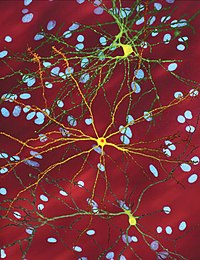
Photo from wikipedia
Gait and balance problems commonly occur in Parkinson's disease (PD). However, balance tasks with only one performance objective (e.g., sit-to-stand) may not be sufficient, compared to dual motor tasks (e.g.,… Click to show full abstract
Gait and balance problems commonly occur in Parkinson's disease (PD). However, balance tasks with only one performance objective (e.g., sit-to-stand) may not be sufficient, compared to dual motor tasks (e.g., carrying a tray while walking), to be applied to the assessments and interventions which are designed to promote PD patients' balance functioning, physical activity (PA) and health-related quality of life (HQoL). The aim of this study, therefore, was to determine whether advanced dynamic balance, measured by a demanding motor-motor dual task, is a significant predictor of PA/HQoL in older adults with and without PD. Participants with (n = 22) and without (n = 23) PD were assessed using the Berg Balance Scale (BBS), the single leg hop and stick series task (SLHS), the Physical Activity Scale for the Elderly (PASE), and the Parkinson's Disease Questionnaire-39 (PDQ39). We calculated the R2 change, namely the incremental validity, between the multiple regression models before and after adding the scores on the BBS/SLHS. While controlling for biological and socioeconomic covariates, competence in the SLHS task provided moderate and large levels of incremental validity to PA (ΔR2 = 0.08, Cohen's f2 = 0.25, p = .035) and HQoL (ΔR2 = 0.13, Cohen's f2 = 0.65, p < .001), respectively. In particular for participants with PD, the SLHS explained significantly more variance in HQoL in relation to psychosocial functioning (ΔR2 = 0.25, Cohen's f2 = 0.42, p = .028) compared to the BBS (p = .296). Assessing advanced dynamic balance by means of a highly demanding dual-task paradigm was not only strongly associated with PA but also covered a wider spectrum of HQoL components. This approach is recommended for use in evaluations and interventions carried out in clinical and research settings in order to promote healthy living.
Journal Title: Human movement science
Year Published: 2023
Link to full text (if available)
Share on Social Media: Sign Up to like & get
recommendations!